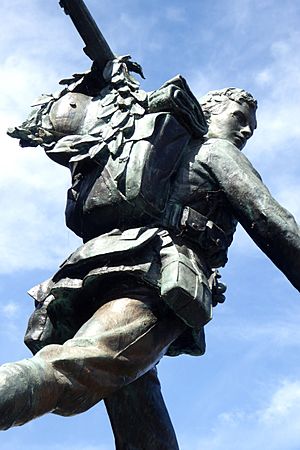Cambridge War Memorial facts for kids
The Cambridge War Memorial is a special monument in Cambridge, England. It stands on Hills Road, Cambridge, right outside the Cambridge University Botanic Garden. This memorial features a bronze statue of a soldier marching, created by Canadian artist Robert Tait McKenzie. People sometimes call the statue "The Homecoming" or "Coming Home." It sits on a stone base with many carvings. The memorial was first shown to the public in 1922. In 1996, it became a Grade II listed building, which means it's an important historical structure.
Contents
Remembering the Great War
After the First World War (1914-1919), people in Cambridge had many discussions about how to best remember those who had died. They talked about what kind of memorial to build, where to put it, and how to collect money for it. Some ideas included building a clock tower, homes for injured soldiers, or making improvements to Addenbrooke's Hospital.
Forming a Committee
In January 1919, a special committee was set up to decide on the memorial. It was led by Charles Adeane, who was the Lord Lieutenant of Cambridgeshire. Members of the committee came from different parts of the community, including the local councils and University of Cambridge. Important people like Arthur Shipley, the head of the University, and Ralph Starr, the Mayor of Cambridge, were part of this group. They also included local business owners and leaders from nearby towns.
Different Memorial Ideas
In April 1919, the committee suggested creating three different memorials:
- One at Addenbrooke's Hospital.
- A list of names of the war dead at Ely Cathedral.
- A large monument in Cambridge itself.
Raising Money for the Memorials
The committee started collecting money in 1919. They hoped to raise about £30,000 for all three projects. Most of this money was meant for Addenbrooke's Hospital. However, collecting funds was slow. By December 1919, only £12,000 had been raised. About £6,000 of this went to Addenbrooke's to build a new home for nurses, which opened in 1924. Many years later, people forgot that this building was originally part of the war memorial effort.
The colleges of the university didn't give much money because they were raising funds for their own memorials. Also, other towns and villages in Cambridgeshire were building their own local memorials.
The Ely Cathedral Memorial
On October 16, 1920, the plans for the memorials in Ely and Cambridge were approved. The Ely memorial became a series of oak panels. These panels were placed in St George's chapel at Ely Cathedral. They list the names of 6,000 people who died in the war, organized alphabetically by town and parish. These panels cost £3,500 and were officially dedicated on May 11, 1922.
The Cambridge Monument
The third memorial was the monument in Cambridge, which became the Cambridge War Memorial. Arthur Shipley suggested that Canadian sculptor Robert Tait McKenzie should design a large statue of a soldier. The original idea was for an 8-foot-tall statue on a 12-foot pedestal.
The committee also approved the location for the monument. It was placed on Hills Road, near the Cambridge railway station, a bit south of the city center. Another suggested spot, Parker's Piece, which was used as a parade ground during the war, was not chosen.
Only £3,500 was left for this monument, but it was expected to cost £4,500. To save money, the statue was made a bit smaller, at 7 feet tall. The architect who designed the overall structure was George Hubbard.
What the Memorial Looks Like
The Cambridge War Memorial is topped by a bronze statue of a soldier. He is wearing the uniform of the Cambridgeshire Regiment. The statue is a bit larger than life-size, standing 7 feet tall. McKenzie based the soldier's look on a student from Christ's College, Cambridge named Kenneth Hamilton.
The Soldier's Pose
The soldier in the statue is shown marching forward with purpose. His rifle is resting on his left shoulder. He seems to be walking home up Hills Road, towards the center of Cambridge. He also glances back over his right shoulder, looking towards Cambridge railway station.
The soldier is bareheaded, holding his helmet in his right hand. In the same hand, he holds a rose, and another rose has fallen at his feet. He carries a laurel wreath on his rifle, which is a symbol of victory. Inside the wreath, he carries a German helmet on his backpack, like a trophy from the war.
The Plinth and Inscription
The statue stands on a rectangular base, called a plinth. It is made of brick covered with limestone and has rounded ends, like an ancient stone coffin. The top part of the plinth has detailed carvings of coats of arms (family symbols).
The lower part of the plinth has an inscription written in red paint. It reads: "TO THE MEN OF CAMBRIDGESHIRE / AND THE ISLE OF ELY, THE BOROUGH / AND UNIVERSITY OF CAMBRIDGE / WHO SERVED IN THE GREAT WAR / 1914–1919"
Later, another line was added to remember those who served in the Second World War: "AND IN THE WORLD WAR / 1939–1945"


